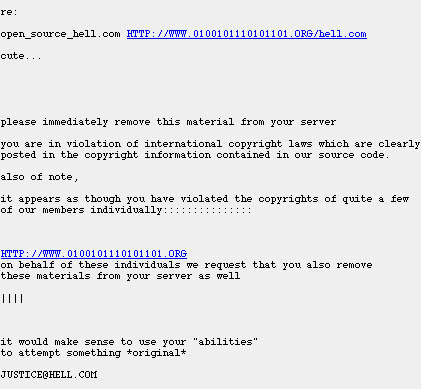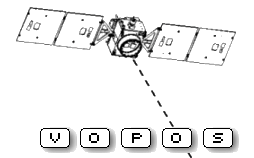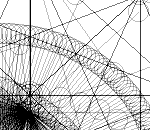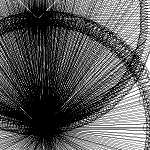 |
[March 16th. 2004]

Email from hell.com in connection to
0100101110101101.org's copying of their site.
'You're in my computer'
www.0100101110101101.org
Majken Kramer Overgaard takes us back a few years in the short history of net art to the artist group 0100101110101101.org's classic net art stunt of copying entire websites to their own site (1999). Continuing forward from this point she tells the story of the group known for taking one of our times' mantras 'information wants to be free' to new extreme heights, and according to their own statement: 'pushing boundaries in any medium we can get our hands on'. Translated by Sofie Paisley.
"Share your knowledge and you will receive immortality"
The above quote is posted on 0100101110101101.org's homepage and is a quote from the Dalai Lama. The numbers in the artist group's name refers to the binary number system, in which computers work. The artists behind it have been anonymous. The anonymity is a manifestation of their resistance towards the cultivation of the artistic subject within the institutionalised art world, which is slowly spreading to art on the net.
In June 1999 they were invited to exhibit in the gallery Art.teleportacia. Instead of creating a net artwork for the exhibit, 01001 sampled the works of the other participating artists, and renamed the exhibition from 'Miniatures of the Heroic Period' to 'Hybrids of the Heroic Period'. Their action was both a reaction against the elevation of the artists participating in the exhibit became subject to, and an illustration of their resistance to terms such as originality and authenticity being used about net art. Originality and authenticity are, according to 01001, not applicable terms on the net. It has no relevance, as digital data cannot be viewed as original, being by definition reducible. Their action at Art.teleportacia was compared to Duchamp painting a moustache on the Mona Lisa. The two actions are, however, not similar as no original exists to be destroyed on the net, which is what 01001 is criticising. Art.teleportacia attempts to create a conception about original works.
On the net the copy is identical to the original. They in this way do not destroy the auratic status of the original, as done by Duchamp, but rather the attempt to transfer the notion of original works onto the net. In their processing of the works at Art.teleportacia, 01001 connect the different works in different, unexpected ways. They treat the works as material, which put together in new ways open up for other meanings and reception possibilities. The artistic material becomes fragmented parts of a ready-made.
Information wants to be free
According to 01001 the Internet has in this way meant a shift in paradigms in relation to art and culture. It is no longer the one and original art work that has an artistic quality, but the availability of and use of information, which becomes the subject of an artistic processing. The process of creation has changed, and it is not the artist's individual creation that is interesting, but rather how the present stream of information is treated. 01001's notion of how art is shaped on the net is based on everyone having equal access to information, and thus also to the artistic material, and everyone should thus have the opportunity of participating in a process of creation.
It is not only the institution of art as representative of an autonomous art, that is criticised, but also the institution as a representative of power structures, which according to 01001, do not belong on the net. The "institution" to be opposed is to the net artists in this way, the commercial, capitalist interests, disregarding the mantra 'information wants to be free'. It is a criticism of the institutional canonisation of the artist as the creating genius, and the adoration of the real and authentic artwork, as it is attempted transferred to the net.
 
Left:From Vopos and right: From Life_sharing.
Glasnost - digital ready-mades
Glasnost is a unified designation for the project containing the two parts, Life_sharing and Vopos. The work is unified an attempt at gathering the largest amount of data about a human being and then making it available on the Internet. 'You're in my computer' are the words which greet you on their site. This statement is to be taken serious, as you are entering the artist's personal computer. The artists have with the work Life_sharing, which is an anagram of the word filesharing, transformed their computer into a form of web server, where the user gains access through the internet, to everything stored on the computer's hard disk. There is free access to everything on the hard disk, you can read their private emails, check their bank accounts, and in short, there is open access to all existing data about the people in question. They use the operating system Linux which is an Open Source system, which unlike for example Windows is not covered by any copyright regulations. The only thing not possible is making changes to what you find, but you can download everything onto your own computer, manipulate the material and then e.g. put it back onto the Internet.
Life_sharing can also be understood as a digital self-portrait of the artists. With their statement, that all digital material in its nature is unoriginal and at no time can be distinguished from the original, they have also set down the staging of themselves. They have translated themselves into reproducible material, as it is no longer possible to distinguish between the original artist and the copy. They thus chosen the absolute consequence of the creation of an anti-auratic work, they have become one with the material of the work, but a material without tangibility and authenticity. They treat the artist role like digital a ready-made. They stage the artist as mass-produced material, and let the creation process take place in the user's treatment of the digital material.
Vopos is a sequel or expansion of Life_sharing. This work explores three types of net connections, the Internet, satellites and the telephone. Through a GPS-transmitter (Global Positioning System), the artist's position is registered and sent over a mobile phone network, and their position is then marked on a map on their homepage.
Both parts of the collective project deals with an exploration of the network's possibilities, both by a strictly formalistic examination of the medium, but also by taking a critical approach to choosing a position on the consumer society, in relation to possibilities for surveillance and registration. In addition, the use of the Linux control system and Open Source is also a political manifestation on the net, i.e. whether the source code should be exposed, and the control system should be open and manipulable, or instead should be hidden as e.g. Windows. This is a technical question based on another understanding of software, and how knowledge is dealt with. The latter becomes the subject of a more fluid form of perception, as the essential is not a fixing and freezing of knowledge, but an exposing of it, so that this knowledge can be generated onwards. In the book Open Sources: Voices from the Open Source Revolution (edited by Chris Dibona, Sam Ockman, Mark Stone), the exposing of digital data is compared to how science is constituted. Science does also not develop if the scientific results are kept unpublicised, but on the contrary, new knowledge is generated through openness, by building on the scientific results of other scientists. Similarly, the software industry needs openness in order to improve and develop itself. This is, however, difficult when companies such as Microsoft have to earn money on the programs they develop, and view the digital data as a commodity. 01001 in this way also rebels against a traditional, capitalist market economy, and view the digital material as a fleeing fluid phenomenon where no one can claim any ownership.
 
Left:From Vopos and right: From Life_sharing.
In addition, Glasnost breaks the previous anonymity of the people behind the project. It is interesting to watch how strongly 01001 prior to Glasnost, caused the creation of myths, and an extreme interest in who were behind the earlier projects, contrary to intentions. After Glasnost was made public and with it themselves, the availability of material on 01001 has had the opposite effect. Their exposed presence has eliminated the conception and the myth about them. They are visible to such an extreme extent that their presence becomes transparent. They become such a large part of the work that their role as creator of the work slips into the background. The artist is present, but as digital material. Similarly, according to 1001, software should not be hidden but be available and useable. Everyone should have the possibility of working artistically and digitally.
The possibility of downloading and manipulating the artistic work material changes the character of the artwork. It becomes, to a high extent, an open and anti-auratic work. It can be discussed at what point in the process the work can be seen as a whole, and if it even manifests itself as a work, built on a perception of wholeness. The works of 01001 are thus open, exposing materials and structure. Both as part of a political choosing of position on how the treatment of digital data should take place, and also as an expression of an artistic, aesthetic form. For 01001, software becomes a cultural expression on the same lines as a picture or a text. The way software is handled thus also becomes subject to interpretation and analysis. Conversely, the way in which data is handled within the open-source movement becomes an expression of how contemporary culture can be understood. The understanding of software as being an open process is transferred onto contemporary culture, which in the same manner develops through building on the results of others, and is thus founded on a collective knowledge process.
More.
http://www.0100101110101101.org/
|
 |
|